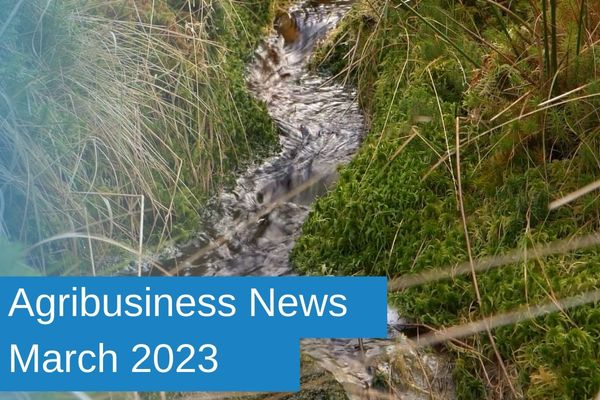Agribusiness News March 2023 – Environment: Peatland Restoration
1 March 2023Peat is amazing, it has been used to heat our homes, flavour our whisky and, when I was little, it helped me to grow carrots. However, when I started walking in the hills, I hated peat. Peat meant battling through sucking filthy bogs, trying to hop from tussock to unstable tussock, sliding down slimy black gullies and climbing through a maze of haggs. Peat meant wet feet, stained clothes, fatigue, and fear of being swallowed in a dirty quagmire. That was in the Dark Peak hills between Sheffield and Manchester.
But then, while at university, my eyes were opened. One of my lecturers showed me the beauty of sphagnum moss under a magnifying glass, revealing the intricacies of the leaves wrapped around tiny branches in wonderful shades of red, pink, green and subtle browns. I also discovered the stunning birds and flowers of a healthy peatland ecosystem and was astonished by volume of water a handful of sphagnum can hold.
Before the current appreciation of the importance peatland restoration, I helped with a small project that tried to reduce the sediment flowing in a little stream. The Pennine peatlands of Lancashire, Cheshire and Yorkshire were hammered by the Industrial Revolution. A toxic legacy of acidic rains and soot reduced the vitality of the plants, and overgrazing and burning created a dark, bleak landscape with swathes of bare peat, hollows and haggs to trap unwary walkers. Peat eroded, washed into the water courses, and occasionally dried into summer dust. Our project was an attempt to reduce the burden on the water companies. If we could reduce the mass of peat entering the rivers and reservoirs it would substantially reduce the water treatment costs. Water flowing from degraded peatlands is “peat tea”, stained with tannins and humic acids and is full of sediment and expensive to treat.
We nailed planks across gullies and used forestry thinnings to slow the flow of water. We tried pegging lumps of turf to block streams aiming to make little ponds. We also used sandbags and stone, taken from some path work. Some of our attempts worked quite well, showing the way forward, but it was difficult, slow, and messy work and there was no money to continue.
Later, as I understood more of the science of climate change, the potential of peatlands to reduce the volume of carbon dioxide added to the atmosphere, became clear to me. Scotland can reduce about 15% of its carbon emissions by fixing its peat bogs. Wildlife gains, water quality gains, flood risks diminish, and landscapes improve, with no lifestyle changes by the public. Peatland restoration is the single most useful thing Scots can do to help heal our degraded land and address the twin emergencies of Climate Change and Biodiversity Loss. Damaged peat bogs leak huge amounts of carbon. Healthy bogs only absorb a little bit of CO2, but crucially, they hold onto it for thousands of years.
The Peatland Action funding programme of NatureScot can pay for most of the restoration of our peatlands. The target is huge, the skilled and experienced workforce small. At SRUC Barony, I lead training programmes to boost the numbers of people who can restore peatland ecosystems.
Ecologists don’t always have an easy relationship with gamekeepers, but when I explained to one why I was driving up his track, he surprised me. The most widespread bog restoration technique in Scotland is to block the grips that draining vast areas of our landscape. These drains were put in to try to dry out the peatlands in order to improve grazing. They seem to have had no real benefit and done a great deal of harm. A typical grip might be 50cm wide and 60cm deep, just enough to trap young grouse. The keeper explained how delighted he was that we were blocking the grips, so he wouldn’t have to pull out handfuls of little bodies from the channels after heavy rain. Fisheries scientists and hydrologists seem to love peatland restoration too. Reduced sediment in the water running off a restored bog means that delicate fish gills are less likely to become damaged and dams don’t fill up with eroded peat. Healthy peatlands smooth out water flow, meaning that small-scale hydroelectric schemes have more consistent and reliable water levels. Salmon need large areas of gravel bottomed burns in which to lay their eggs and have them successfully hatch. Peat sediment smothers and kills fish eggs and many of the aquatic invertebrates small fish need to eat.
The Scottish Government, through NatureScot’s Peatland Action programme, has allocated £250 million pounds to restore 250,000 ha by 2030. In the last ten years we’ve managed about 30 000 ha. To restore the rest, we’ll need about 1,500 more people who have the relevant skills. The SRUC/ NatureScot training courses are trying to address this need, by teaching how to survey, map and assess the condition of peatlands and how to select and evaluate the most appropriate restoration techniques. By providing training in all the aspects of the design process, we are aiming to enable participants and the companies they represent to access the Peatland Action funding and develop effective projects. Together we hope to facilitate a workforce that can take Scotland on a journey towards Net Zero and a richer biodiversity.
Sign up to the FAS newsletter
Receive updates on news, events and publications from Scotland’s Farm Advisory Service

